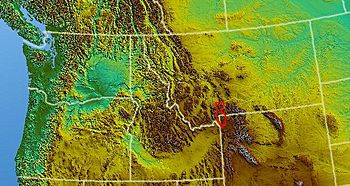Gallatin Range facts for kids
Quick facts for kids Gallatin Range |
|
|---|---|
| Highest point | |
| Peak | Electric Peak |
| Elevation | 10,969 ft (3,343 m) |
| Geography | |
| Country | United States |
| Parent range | Rocky Mountains |
The Gallatin Range is a group of tall mountains. They are part of the larger Rocky Mountains system. You can find them in the states of Montana and Wyoming in the United States. More than 10 mountains in this range are over 10,000 feet (about 3,048 meters) high! The very highest point is Electric Peak, which stands at 10,969 feet (3,343 meters).
The Gallatin Range got its name from Albert Gallatin. He was a very important person in early American history. He served for a long time as the United States Secretary of the Treasury. This job is like being the main money manager for the country. The range stretches about 75 miles (120 km) from north to south. It is usually about 20 miles (32 km) wide.
Contents
Where is the Gallatin Range?
The mountains at the very south end of the Gallatin Range are inside Yellowstone National Park. However, most of the range is in the Gallatin National Forest. The Yellowstone River flows north along the eastern side of these mountains. To the west, you'll find the Madison Range, which runs parallel to the Gallatins.
The northern part of the range is close to Livingston, Montana. A place called Bozeman Pass separates the Gallatin Range from the Bridger Mountains to the north.
Amazing Animals of the Gallatin Range
The Gallatin Range is a very important part of the Greater Yellowstone Ecosystem. This is a huge area where many animals live freely. You can find many of the same animals here as in Yellowstone National Park.
These include amazing creatures like grizzly bears and wolves. Some of these animals are considered threatened or endangered species. This means their populations are very low, and they need protection to survive.
Ancient Trees: The Petrified Forest
Inside the Gallatin Range, there is a special place called the Gallatin Petrified Forest. It is one of the biggest petrified forests from the Eocene Epoch. This was a time about 50 million years ago!
Petrified wood is basically wood that has turned into rock. This happens when minerals replace the original wood over millions of years. In this forest, you can see both logs that were carried there by water and tree trunks that grew right where they are found. These "in place" trees are rooted in old fossil soils, called paleosols.
The petrified logs and trunks in the Gallatin Range were buried by volcanic mudslides. These mudslides are called lahars. Sometimes, these lahar deposits were moved again by small streams. All these sediments built up about 50 million years ago. The U.S. Forest Service has a special 2-mile (3.2 km) long trail. This trail helps visitors learn all about these amazing petrified trees.
It's important to remember that collecting fossils in Yellowstone National Park is against the law. Also, visitors should always stay on marked trails to protect these special areas.
Images for kids
See also
 In Spanish: Cordillera Gallatin para niños
In Spanish: Cordillera Gallatin para niños




